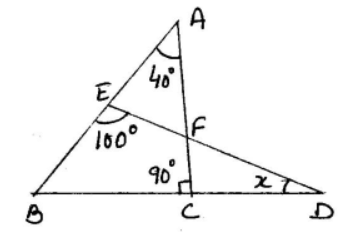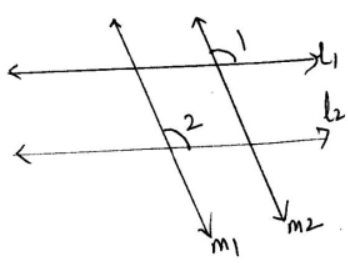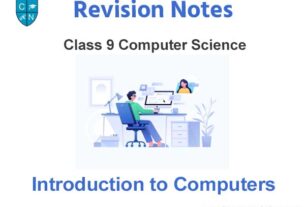Please refer to Lines And Angles Class 9 Mathematics notes and questions with solutions below. These revision notes and important examination questions have been prepared based on the latest Mathematics books for Class 9. You can go through the questions and solutions below which will help you to get better marks in your examinations.
Class 9 Mathematics Lines And Angles Notes and Questions
Key Concepts
(1) Point – We often represent a point by a fine dot made with a fine sharpened pencil on a piece of paper.
(2) Line – A line is completely known if we are given any two distinct points. Line AB is represented by as ↔AB . A line or a straight line extends indefinitely in both the directions.

(3) Line segment – A part (or portion) of a line with two end points is called a line segment.

(4) Ray – A part of line with one end point is called a ray.

(5) Collinear points – If three or more points lie on the same line, they are called collinear points otherwise they are called non-collinear points.
Types of Angles –
(1) Acute angle – An acute angle measure between 00 and 900.
(2) Right angle – A right angle is exactly equal to 900.
(3) Obtuse angle – An angle greater than 900 but less than 1800.
(4) Straight angle – A straight angle is equal to 1800.
(5) Reflex angle – An angle which is greater than 1800 but less than 3600 is called a reflex angle.
(6) Complementary angles – Two angles whose sum is 900 are called complementary angles.
(7) Supplementary angle – Two angles whose sum is 1800 are called supplementary angles.
(8) Adjacent angles – Two angles are adjacent, if they have a common vertex, a common arm and their non common arms are on different sides of common arm.
(9) Linear pair – Two angles form a linear pair, if their non-common arms form a line.
(10) Vertically opposite angles – Vertically opposite angles are formed when two lines intersect each other at a point.
TRANSVERSAL
(a) Corresponding angles
(b) Alternate interior angles
(c) Alternate exterior angles
(d) Interior angles on the same side of the transversal.
* If a transversal intersects two parallel lines, then
(i) each pair of corresponding angles is equal.
(ii) each pair of alternate interior angles is equal.
(iii) each pair of interior angle on the same side of the transversal is supplementary.
* If a transversal interacts two lines such that, either
(i) any one pair of corresponding angles is equal, or
(ii) any one pair of alternate interior angles is equal or
(iii) any one pair of interior angles on the same side of the transversal is supplementary then the lines are parallel.
* Lines which are parallel to a given line are parallel to each other.
* The sum of the three angles of a triangle is 1800.
* If a side of a triangle is produced, the exterior angle so formed is equal to the sum of the two interior opposite angles.
Question. The compliment of an angle ‘m’ is:
(a) m
(b) 900+m
(c) 900-m
(d) m X 900
Answer
C
Question. If one angle of a triangle is equal to the sum of the other two equal angles, then the triangle is
(a) an isosceles triangle
(b) an obtuse triangle
(c) an equilateral triangle
(d) a right triangle
Answer
A,D
Question. In the given figure ∠a and ∠b form a linear pair if a-b = 1000 then a and b are

(a) 1200, 200
(b) 400, 1400
(c) 500, 1500
(d) 1400, 400
Answer
D
Question. Angle of a triangle are in the ratio 2 : 4 : 3. The smallest angle of the triangle is
(a) 600
(b) 400
(c) 800
(d) 200
Answer
B
Question. In the given figure, The value of y is

(a) 100
(b) 400
(c) 360
(d) 450
Answer
B
Question. An exterior angle of a triangle is 750 and its two interior opposite angles are equal. Each of these equal angles is
(a) 1050
(b) 50.50
(c) 520
(d) 37.50
Answer
D
Very Short Answer Type Questions :
Question. In the adjoining figure, AB, ll DE , find the value of x.

Answer: 95°
Question. In the given figure AB and CD intersect each other at O. If ∠AOE = 75° find the value of x , y and z .

Answer: 84°, 21°, 48°
Question. In the given figure DE ll QR and AP and BP are bisectors of ∠EAB and ∠RBA respectively find ∠APB

Answer: 90°
Question. The angles of a triangle are in the ratio 2: 3: 5 find the angles of the triangle.
Answer: 36°, 54°, 90°
Question. Find x and y in the following figure.

Answer: 48°, 12°
Question. In the given fig. sides QP and RQ of ΔPQR are produced to point S and T respectively. If ∠PQT = 110° and ∠SPR = 135° find ∠PRQ

Answer: 65°
Question. In figure find x.

Answer: 30°
Question. The angles of a triangle are (x – 40°) , (x – 20°) and (1/2 x – 10)° find the value of x.
Answer: 100°
Question. In the given figure, AD and CE are the angle bisectors of ∠A and ∠C respectively If ∠ABC = 90° then find ∠AOC

Answer: 135°
Question. In the fig. l2 ll l2 and m1 ll m2 if ∠1 =115° find ∠2

Answer: 115°
Question. Sum of two angles of a triangle is 900 and their difference is 500. Find all the angles of the triangle.
Answer: 20°, 70°, 90°
We hope the above Lines And Angles Class 9 Mathematics are useful for you. If you have any questions then post them in the comments section below. Our teachers will provide you an answer. Also refer to MCQ Questions for Class 9

